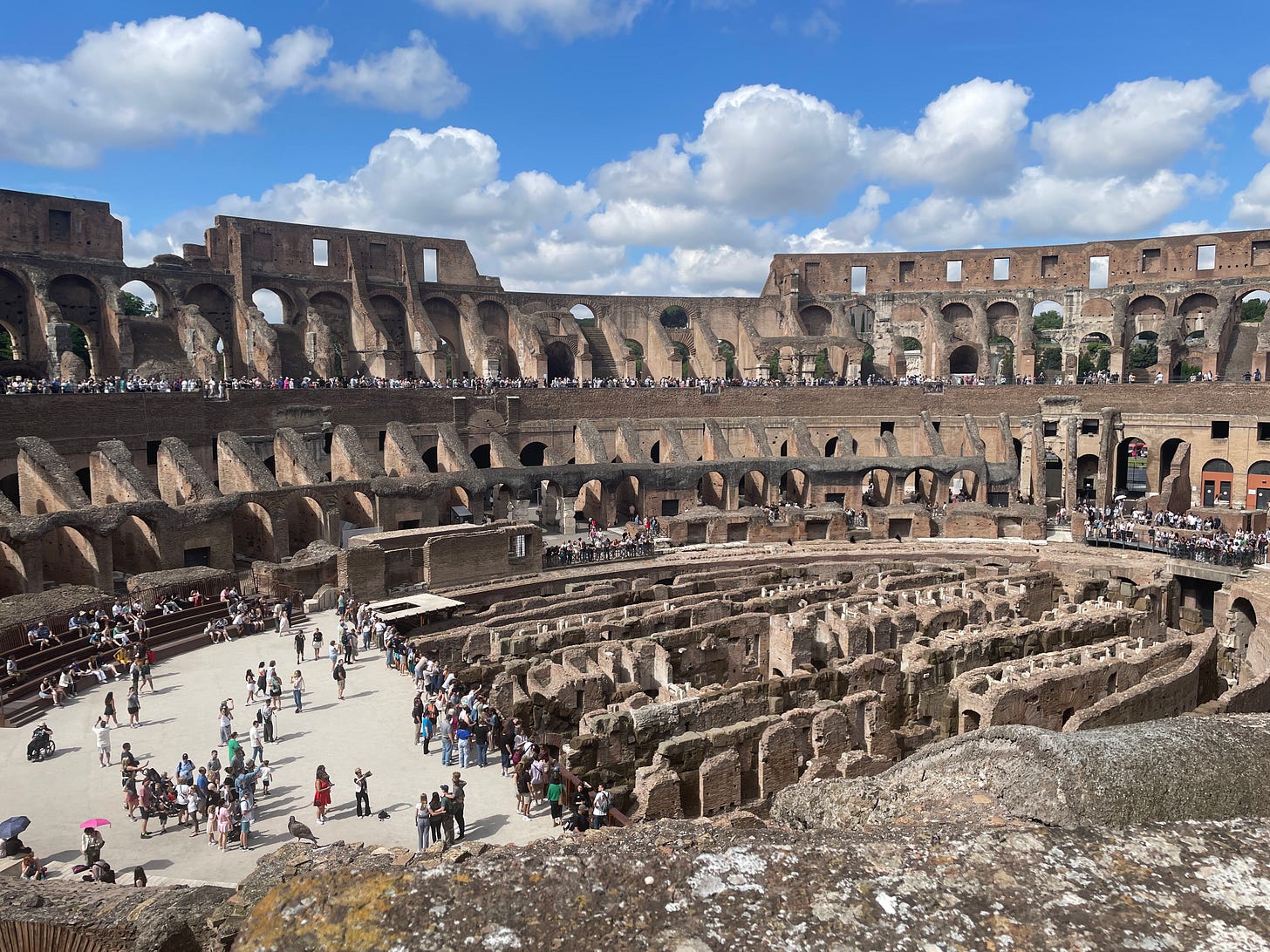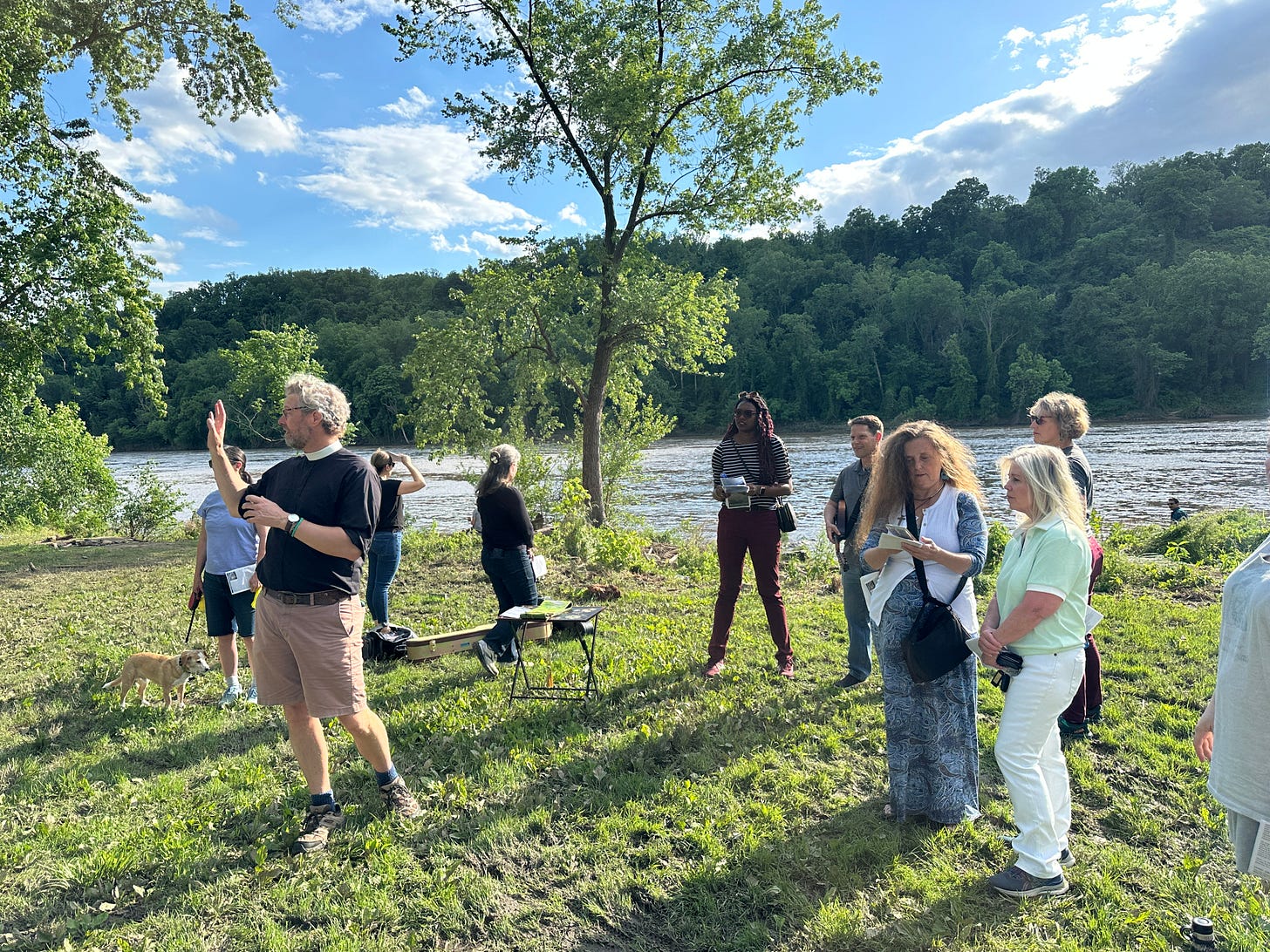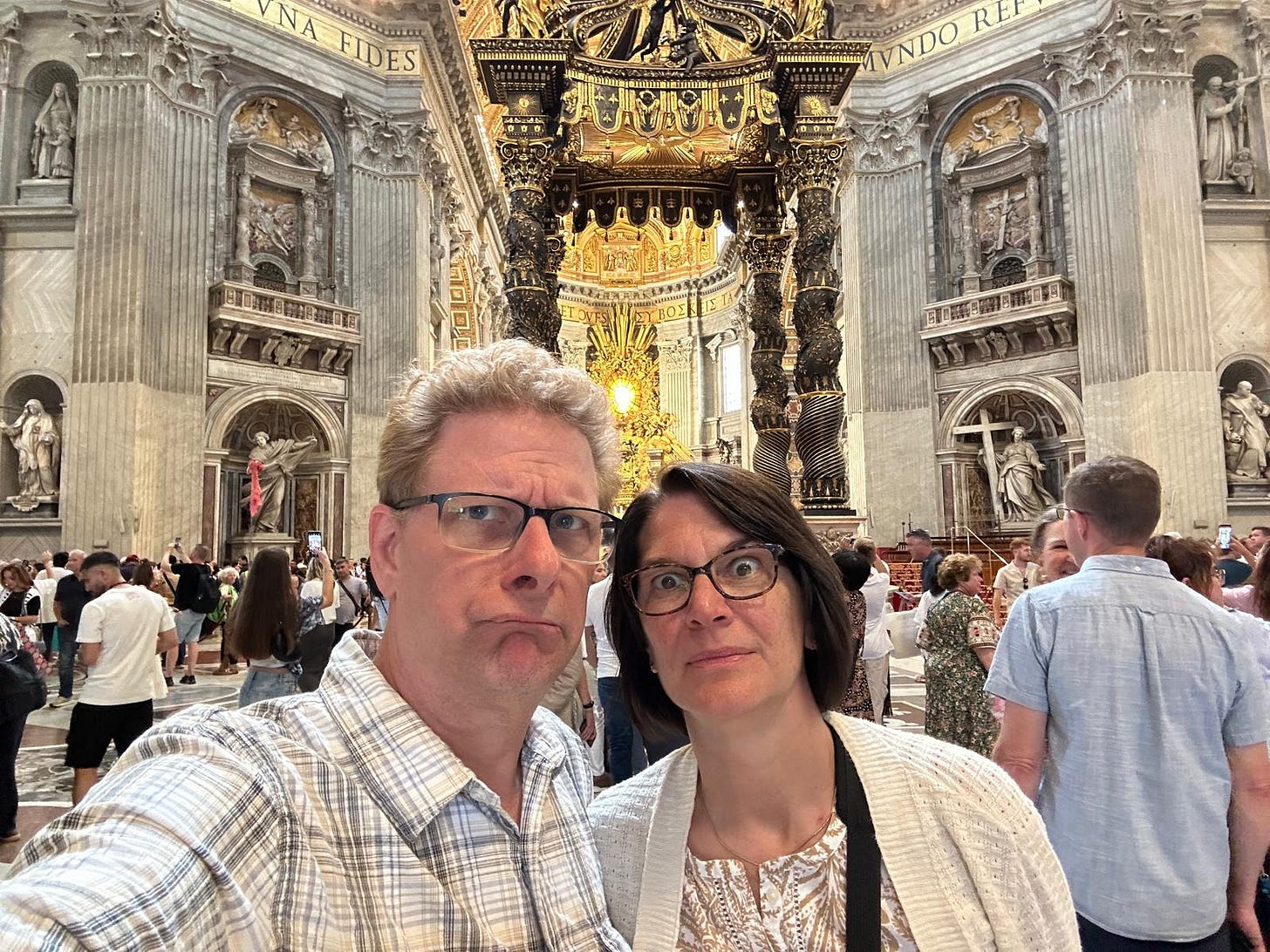Refugia Newsletter #94
Italy, Greece, ruined civilizations, Black food security, outdoor worship, and a dragon with indigestion
Refugia News
Hello, friends. I’m coming to you today from… Italy! Spouse Ron and I are taking a bucket-list trip to celebrate a certain milestone birthday for both of us. I’ve never been to Italy or Greece before—these were the only destinations on my very short bucket list. We’re calling this the “Ruined Civilization Tour.” Which seems, I’m afraid, rather apt.
I have tried very hard not to pay attention to news on this trip. When I say I need a brief detox, I’m sure you know what I mean. So would you all please take over my portion of the usual anxious worrying about things in the US for a couple weeks? I’ll be back at it soon enough. Thanks.
To help you through the worrying, you might check out a new episode of the podcast The Thing with Feathers, with the lovely Courtney Ellis. Courtney and I talked about birds, refugia, hope, and other good stuff.
Below I’ll tell you about a couple great recent refugia sightings, too.
The Colosseum really is impressive, even in ruins. Ron and I kept thinking about University of Michigan stadium, the “Big House.” Which is, of course, bigger than the Colosseum. Modern stadiums (stadia?) are eerily similar to this ancient structure.
This Week in Climate News
First, just a bit of news. This is old stuff: forgive me for not keeping up with the daily spasms. I hope you’re all OK over there.
We were just in Vatican City. So of course I waved “hi” to the new pope, Pope Leo XIV. I wrote last time about the pope’s evident commitment to climate action on behalf of the poor and the earth. Here’s another helpful interview with Dr. Erin Lothes, environmental theologian, author, Laudato si’ movement leader, and former professor of Catholic theology. Dr. Lothes gives her hopeful perspective on how the new pope can advance the global faith/climate movement. You can read the transcript or listen to the interview here at Inside Climate News.
Remarkably, May 24 was the official tenth anniversary of Laudato si’. Here’s a quick peek at events around the world to celebrate the anniversary. For the US, The National Catholic Reporter featured ten dioceses that are actively working on climate action. Lots of solar panels, divestment, tree-planting, and net zero pledges. Also look for “Pilgrims of Hope for Creation” events coming up during the Season of Creation from September 1 to October 4.
I mean, obviously one is going to arrange the panels in the shape of a cross. This is the campus of the University of St. Mary of the Lake/Mundelein Seminary in Mundelein, Illinois. Image credit: UMSL/Mundelein Seminary.
Meanwhile, back in the crazy US, we have EPA Administrator Lee Zeldin trying to disparage climate action by referring to “climate change religion.” Sure, while he’s viciously slashing environmental protections and genuflecting to the oil industry. This article by James Bruggers of Inside Climate News nicely sums up faith leaders’ objections to this propaganda. Hat tip to Rabbi Jennie Rosenn of Dayenu, for noting wryly that Zeldin (who is Jewish) “managed to denigrate religion, science and efforts to address the climate crisis all in one fell swoop.” Also points to her for using the phrase “fell swoop” (it’s from Shakespeare).
I found it especially remarkable that Rev. Mitch Hescox, emeritus president of the Evangelical Environmental Network, had no problem calling Zeldin out in strong terms. He described how this kind of propaganda was also used in the 1990s to come after people of faith and pretend that their environmental concerns amounted to some kind of cult. Bruggers quotes Hescox:
With so many people of faith now recognizing the threats of climate change and health impacts of air pollution, as well as advances in less expensive cleaner energy technology such as wind and solar, Hescox said Zeldin’s “religion” rhetoric appears to be aimed at an increasingly small audience of very conservative Christian evangelicals. But in articulating their deregulatory agenda, the Trump administration is practicing another religion—“the religion of fossil fuels, for their own self interests,” he said.
Take that! Preach it, Rev. Hescox!
Well, whatever is happening with the Horrible, Rotten, Cruel, Nasty budget bill, you might take heart in this recent article in Grist in collaboration with Vox, titled “10 charts prove that clean energy is winning—even in the Trump era.” It’s a handy summary of stuff I’ve talked about before in this newsletter, but the bottom line is: money. The economics are undeniably in favor of clean energy.
Action item: keep hounding your US House and Senate reps to save clean energy incentives as the budget sausage keeps grinding.
Refugia Sightings
We’ll skip the Deeper Dive today and jump right to Refugia Sightings, since I have two good ones for you.
Ron and I interviewed Rev. Dr. Heber Brown III in Baltimore last week. Brown is the founder of the Black Food Security Network, which their website describes as “a national network of Black churches, organizing to advance health, wealth, and power in our communities.” They “co-create Black food ecosystems anchored by Black churches working in partnership with Black farmers and other organizations.”
It’s such a great refugia story! Brown began simply by noticing that his congregants were dealing with diet-related diseases, and he wondered how they could address this problem as a community. So they started with one church garden. That grew into farmer’s market events on Sundays which grew into connecting with Black farmers, and now—after a lot of relational network-building—the Black Food Security Network comprises 250 churches and 100 Black farmers, up and down the East Coast and beyond. It’s a great illustration of the refugia principle that “small is not insignificant.” Sometimes refugia spaces thrive and connect and become a renewed ecosystem—in this case a foodshed built on self-reliance, relationships, ingenuity, and food justice.
Rev. Dr. Heber Brown III telling the story of the Black Food Security Network. Note the book on his lap—a gift from me, of course.
The second stop on our interview mini-tour was Washington, DC, where we interviewed Father Pete Nunnally, found of Water and Wilderness Church. Here’s their website description:
Water and Wilderness Church is for anyone anywhere who yearns for a wilder faith in a bigger God. It’s more than a church, it’s a watershed community of people near and far who seek authentic connection to God and one another through nature-based worship, book studies, and immersive nature retreats. We are expansively Christian, radically affirming, and unbounded by artificial borders and rigid doctrine. Bring your mess, your voice, and your whole self!
After an engaging interview with Father Pete, we got to attend their outdoor worship in Fletcher’s Cove, a park right on the Potomac in the western part of DC. What a kind and engaged group! There were about twenty of us, and the service involved walking from one site to another in the park. We shared our reflections on the scripture passage in a “group homily,” spent a little time in solo reflection, prayed, sang, and celebrated Eucharist.
Father Pete looks as if he’s striking a medieval teaching pose here!
Water and Wilderness Church has just been recognized by the Episcopal Diocese as an “official” church. Father Pete would definitely want me to say that anyone, anywhere can be a part of this watershed community. Thankfully, as humans with online tools, we can build those refugia corridors even when we’re not in physical proximity to each other.
You’ll be able to hear the full interviews with both Heber Brown and Pete Nunnally this fall on the Refugia Podcast. I’ll keep you posted.
Climate Art
I forgot to tell you last time about a super cool piece Ron and I heard performed by the Grand Rapids Symphony. The piece is called Earth 2.0, with music composed by Jake Heggie and libretto by Anita Amirrezvani. It was wild! Here’s the description from the program:
An unusual cross between an opera and song cycle, Earth 2.0 was composed for and stars countertenor Key’mon Murrah – who possesses a spectacular soaring soprano range – and features two dancers with choreography by Jawole Willa Jo Zollar, founder of the legendary NYC-based dance troupe Urban Bush Women.
The concise, poetic libretto by Amirrezvani gives an emotional perspective from Earth itself, taking the audience into the very heart of Earth’s dilemma. We all know what it is to be in a toxic relationship, wondering how long you should wait for the other person to change – or whether it’s time to call it quits.
Basically, the counter-tenor plays the role of the Earth and the two dancers represent humans. The relationship is beautiful—at first. And then the humans get too big for their britches and start destroying the earth. It was heartbreaking to watch (and hear) this.
I sat there expecting that the final movement would represent humans figuring out how badly they were acting, repenting, and reconciling with earth. But nope! The ending was dark: the earth says, more or less, “Well, you guys are going to destroy yourselves, but I’ll go on. There’s more to life than you!”
Yikes. How fascinating that such gorgeous music, singing, and dancing could convey this dire warning. I thought the piece was deeply affecting—the audience seemed to think so as well. If you ever get a chance to hear it, I recommend doing so.
Extra Bonus Photos from the Trip Just for Fun
Just a couple nice ones to round this newsletter out. Next time I’ll be back with the usual news roundup, deeper dive, and more.
A view of Florence from the Piazzale Michelangelo.
David really is amazing in person. That face!
Bernini was a genius, and Saint Peter’s Basilica is about as splendiferous as anything can be. But we two boring Midwestern American Protestants found it all… a lot.
From Santa Maria Novella in Florence. The best thing about frescos is noticing the artists’ more humorous touches. I don’t know what this poor dragon has been eating, but it doesn’t agree with him.
Thanks for indulging me. Till next time, be well.












Was just talking with someone two days ago who describe just how indispensable this newsletter is every fortnight. And this week, we get photos from ruined civilizations to boot. (I mean, not to boot the ruined civilizations, but you know what I mean...) Thanks for being such a persistent, detail-attentive, good-humored writer.